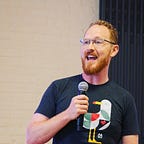Decisions: Made Simple
Here’s the easiest way to make any decision, more simple:
- What’s my default action?
- What would cause me to re-evaluate?
- What’s the point of no return (where any decision would be final)?
- Act on the default until re-evaluation (#2) is required.
While most people think they’re doing this now, they’re not. Instead:
- We acknowledge there’s a fall back (and hate it)
- Find a reason to delay making an official decision (and delay it)
- Get to the point of no return and make an even less ideal decision (and promise to yourself and your co-workers/friends/partner that “next time we’ll make sure to do this differently!”)
- Repeat steps 1–3
Steve Jobs and Mark Zuckerberg have famously made the decision of what to wear, simple. So simple, that they wore/wear the same thing almost every day.
The purpose was/is: 1) to reduce the total cognitive load of less important decisions; 2) rely on a suitable default that achieves the outcome; and 3) allow the mind to spend its precious energy on the things that bring the most value.
A stack overflow is an undesirable condition in which a particular computer program tries to use more memory space than the call stack has available. In programming, the call stack is a [bucket] that stores requests that need to be handled.
As I work with more and more professional problem solvers (entrepreneurs, software engineers, etc…) I see the same issue: too many things to focus on and too many “important” decisions to make; they’ve overloaded their “stack”.
The initial fear of acting on a default decision is that: 1) It will be wrong/bad; or 2) It won’t represent my/our potential.
We’re perfectionists, and the decisions we make represent us (and, so do the decisions we don’t make).
Clearly identifying the default decision — and what will cause us to re-evaluate and when it won’t matter anymore — puts the focus on what will influence change and whether that has any true relevance.
If I’m tasked with making dinner for my wife and I, it’s really easy to be overwhelmed: What’s in the kitchen? How long will it take to make? Do I have enough time? etc. Instead, we have a couple of defaults.
If push comes to shove, we make rice bowls: brown rice, vegetables, black beans, salsa, Yumm! sauce (Oh, God!), and whatever else strikes our fancy. If, and only if, I have the ability to invest the time, I will.
Now, to keep this from being an excuse to get lazy, I determine what would cause me/us to re-evaluate (example: date night). But again, there’s a default: Plumeria in San Diego or one of the select restaurants in our home town(s).
The key here is to have a simple default and know, under what conditions, should I re-evaluate. I don’t care much beyond that. If I get down to the purpose of the making a decision, rarely is it directly correlated to the thing I’m making a decision about (example: eating food vs. connected with my wife).
Here’s the common myth I hear entrepreneurs regurgitate: My job is to make quality decisions. Sort of. Your job is to solve problems, through action. A prerequisite is to be a decision maker.
By getting in the habit of conceptually making any decision more simple, we set ourselves up to act more quickly and more objectively. The net effect is more focus spent on what brings the most value.
Challenge: For the next two weeks follow this process. Define: the decision you have to make; what’s the default action; what’s the point of re-evaluation; what’s the point of no return.
Like anything, it will take time to get used to the process. But over time, it will become second nature.
I’m a speaker and co-founder of a custom web and mobile applications consultancy. We empower visionaries to make better, more focused problem solving decisions. Learn more at codingzeal.com
